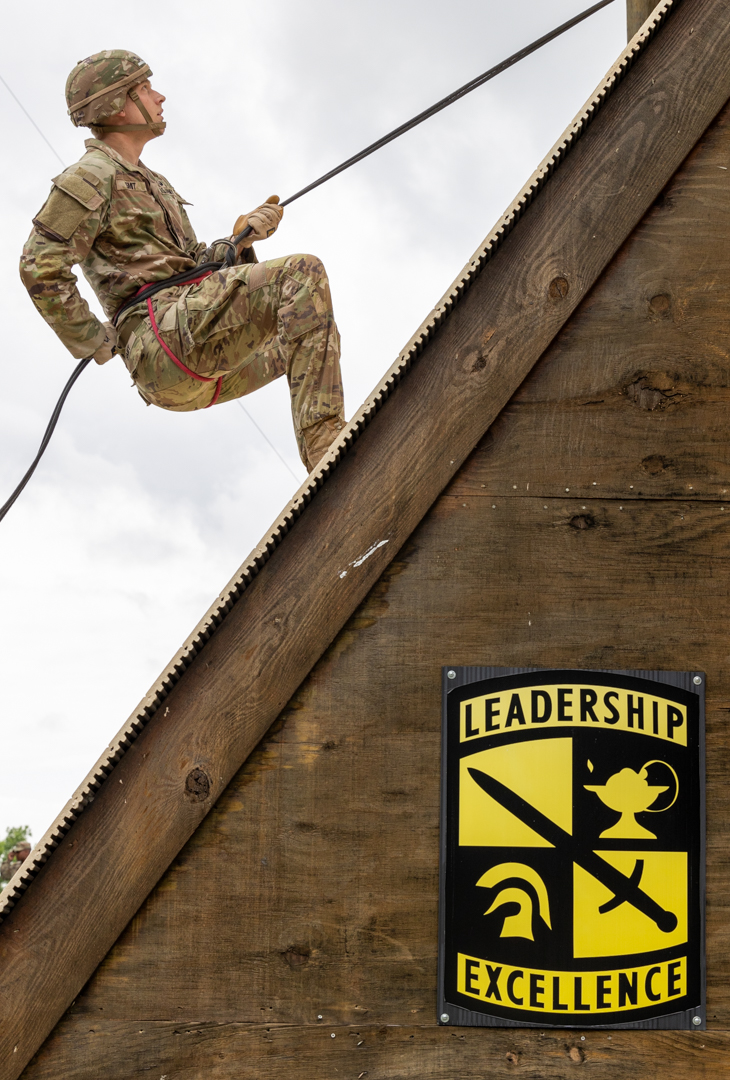


FORT KNOX, Ky.- Cadet Caleb Smit from the University of Minnesota, 1st Regiment, Advanced Camp, rappels down the small-scale wall on Fort Knox, KY., June 5, 2024. Before descending the 64-foot rappel tower, cadets must complete several preparatory steps, including practicing on the small-scale wall, to familiarize themselves with the equipment. “It’s always fun going down when you let go and start jumping instead of doing baby steps,” said Smit, who has prior experience with rappelling. “It’s a good time, I encourage anyone to do it.”
The goal of rappel tower training is to equip Cadets with the skills to get past their fears, while also fostering team unity. The rappel tower acts as a confidence enhancer, as confidence is important for navigating the various training activities during camp.
“The exercise they’re trying to do is build confidence in themselves as well as confidence in their equipment,” said Rappel Master Sgt. 1st Class Paul Robertson, Jacksonville University, Reserve Officers’ Training Corps Instructor. Cadets must undergo this training so that they can later commission and assure their soldiers that they can overcome challenges because they have experienced them firsthand.
Before descending the rappel tower, cadets observe a demonstration on the correct technique, paying close attention to hand and foot placement, commands, and procedures in case of any issues during the descent. Following the demonstration, cadets’ line up to learn how to tie their rope into the rappel seat, also known as the Swiss Seat.
Once they have tied their ropes and put on their rappel gloves, cadets undergo the Rappel Master Personnel Inspection. After any attempt on the rappel wall, cadets must pass through RMPI to ensure their ropes are securely tied and their gloves are intact, ensuring their safety.
Prior to descending the 64-foot rappel tower, cadets practice on a smaller scale wall to familiarize themselves with their equipment and acclimate to the height. After successfully passing the RMPI inspection post small-scale wall, cadets ascend 64 feet of stairs to reach the top, applying the skills they acquired during ground training.
Many Cadets approach this training with varying degrees of fear or ease. Cadet Adrian Paselio from the University of Hawaii, 1st Regiment, Advanced Camp, admits to struggling with a fear of heights. For her, tackling the rappel tower required significant mental preparation and deep breaths. “Once I got up there, the only thing that came to mind was that this will all be over.” said Paselio.
On the other hand, Cadet Emmanuel Bimpong from the University of Cincinnati, also part of 1st Regiment, Advanced Camp, faced the training with a smile. Offering advice for future Cadets, “Believe in yourself and trust that everything will be great as long as you prepare and trust yourself,” said Bimpong.
Despite their differing approaches, all Cadets share the understanding that regardless of fear or confidence, the only way down the 64-foot rappel tower is off the edge.
Upon reaching the ground, the Cadets step back until they are clear of the rope, taking a deep breath as they realize they have progressed one step further towards completing camp.

